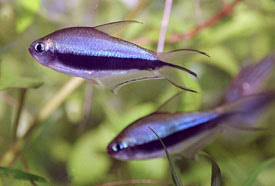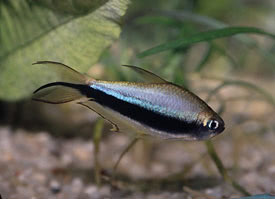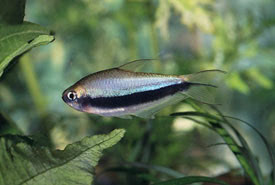
 Magyarul / Hungarian
Magyarul / Hungarian



- Scientific name: Nematobrycon palmeri
- Common name: Emperor tetra
- Group: Characins
- Habitat: South America; The Rio San Juan and the Rio Atrata of the watershed of Western Columbia.
- Size: 5-6 cm
- Biotope: Slow-moving rivers
- Social behavior: A territorial fish that can be kept in a community tank. A male will establish his own territory and only allow juvenile or ready-to-spawn females to enter it. Keep one male with two or more females. Males are aggressive towards each other and often the smaller or weaker is killed during a conflict. A dominant male may pick on a female fish.
- Diet: Flake, live, insect larvae, Brine Shrimp, Tubifex, occasionally offer boiled spinach and vegetable flake foods.
- Breeding: Quite easy
- Tank: Minimum 100 litres
- Population: 8-10 fishes for 150 litres
- Decoration: The tank must be arranged in dark colors to have this fish's splendid colors to come out. The lighting should be subdued by a cover of floating plants. Provide dense planting for hiding. A piece of driftwood should be used to serve as a retreat for a harassed female.
- Temperature: 24-26°C
- pH: 6,7-7.
- Hardness: 4-8,5 NK°
- Lifespan: 4-6 years
Description: The body is "club-shaped." The dorsal fin is elongated and has a dark fringe on its edge. The other fins also have dark fringes with yellow base coloration. The back is olive brown. A broad iridescent stripe extends from the eye to the base of its tail. The stripe ranges in color from yellow to green to blue to violet and even black. Below this colorful stripe is a broad black band. No adipose fin is present.
The male is higher backed with age, has longer fins, including elongated dorsal fin. The male is much more colorful.
Spawning is fairly easy. The major difficulty usually encountered is the incompatibility of a pair. If this occurs, try a different female. The compatible pair should be placed in a 16" (40 cm) or 5 gallon (19 L) tank. Use no substrate. The water should have a pH from 5.0-6.0 and a water hardness of 2-8 dH. Use fine leafed plants or Java Moss as a spawning substrate. Keep the pair separated in different tanks for two-three weeks prior to spawning, and feed them on a varied diet of black mosquito larvae, glassworms, bloodworms, and Daphnia. Spawning follows after the female assumes a head-down position in the plants. Each time the pair embraces, a single egg is produced. This process continues for three-four hours and produces up to 150 eggs. After spawning, the male will attack the female, unless plenty of hiding places are provided. Remove the pair. The clear eggs hatch in 24-30 hours. The clear, transparent fry cling to plants and the glass tank sides. In five days, the young are free-swimming. At that time they can be fed powdered foods and Infusoria. After three-four more days, the fry can be fed larger foods such as brine shrimp nauplii. After two weeks, the young begin to develop the characteristic band that extends from the snout through the tail. The fry require frequent partial water changes to prosper. Try to feed the fry a varied diet.










